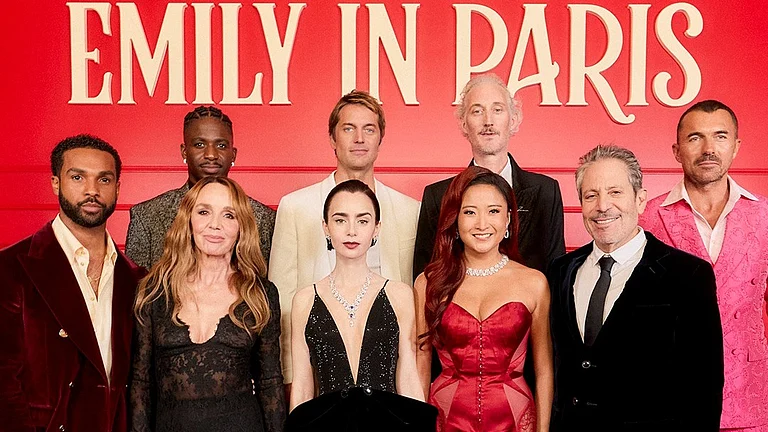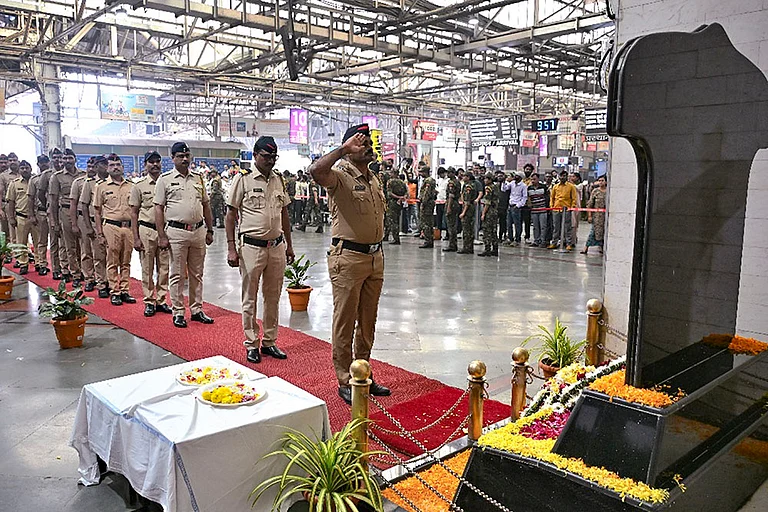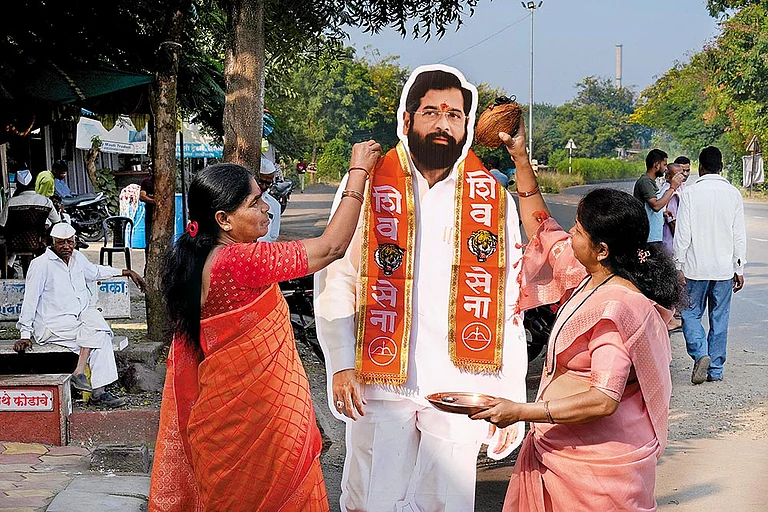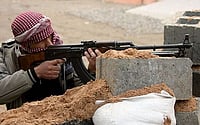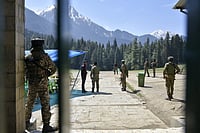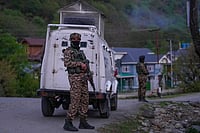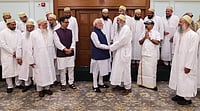Bollywood action drama, Tirangaa, starring yesteryear hero Raaj Kumar and Marathi actor Nana Patekar is a largely-forgotten gem from the run-of-the-mill films of the 1990s. In Maharashtra, the movie has a separate fan base for a particular dialogue.
Most of the movie follows Patekar in the role of Shivajirao Wagle, an honest, but hot-headed police inspector who is enrolled by Brigadier Suryadev Singh (Raaj Kumar) in an important mission to stop enemies from building dangerous missiles to destroy India.
In a stand-out scene, an inebriated Wagle, who has come to meet his love interest, is suddenly ambushed by a group of goons. In that drunken state, Wagle beats the goons and drives them away. He steadies himself while embracing the frightened lady and mutters an iconic line: aandu pandu samja hai kya, Maratha hai mein Maratha (Did you think I am some Tom, Dick or Harry, I am a Maratha).
Wagle asserting his Maratha identity in a power-punched delivery struck a chord with the audience. Cinema halls across the hinterland erupted with hooting and whistling when the film was released in 1993. It brought alive the memory of the glorious military exploits of the Marathas on the silver screen, reawakening the pride and bravery associated with the community.
Generically, in Maharashtra’s popular culture, beyond the complex caste identities, the term Maratha has come to be associated with an expression of militant prowess or foot soldiers of Shivaji’s army. But historians and anthropologists studying Maharashtra’s regional history allude that the term Maratha is ambiguous.
The people of Maharashtra staying outside the state are often confusedly referred to as Marathas, presumably due to their linguistic identity as Marathi speakers. But historically, the term ‘Maratha’ itself is contested and contrived within the social and political milieu of Maharashtra, and so has the regional identity of the Marathas.
For a long time, the term Maratha had an element of ambiguity, says Prabodhan Pol, assistant professor at the Manipal Centre for Humanities, and it could be associated with anyone belonging to the sphere of power, elites, bureaucracy or administration. “There is an assumption that Maratha history is associated with the Maratha caste or community, but the ‘Maratha caste’ identity is a modern construct which emerged only in the 19th century.”
The caste became entrenched in the 20th century with the creation of Maratha history, starting from Shivaji’s birth to the fall of the Peshwa rulers, and framing the history of various elite factions and aristocratic Marathas as regional Maratha identity. The conception of the Maratha caste became integral to the social and caste dynamics with the addition of Kshatriya (warrior) discourse and internal class conflicts with the Kunbis.
Today, the Marathas are a dominant group comprising several castes and sub-castes belonging to the peasantry and Kshatriya traditions, who represent nearly 30 per cent of the state’s population. The feudal and aristocratic families like Pawars, Chauhans, Patils, Vikhe-Patils, Mohite-Patils and others have held the reigns of political and social power in post-independent Maharashtra. From 1920 till 1990, the community maintained an undisputed political dominance.
The rise of the Other Backward Classes (OBCs) category, post-Mandal, challenged this hold. Grappling with the grim realities of rural and agricultural crisis and unable to cope with rapid industrialisation, a section of the Marathas began seeking reservation in the 1980s in the OBC category.
The quota movement continues till today, led by Manoj Jarange Patil, a frail grassroots leader from the Marathwada region. In February this year, The Bharatiya Janata Party (BJP)-led Chief Minister Eknath Shinde government granted a 10 per cent special reservation in education and government jobs. Patil remains dissatisfied over his main demand for the inclusion of Marathas into the OBC category by recognising them as Kunbis.
“Patil has become a representative of the embittered and wounded Marathas, who cannot let off the arrogance associated with their identity. He talks of reservation for the Marathas, while ridiculing the Dalits and the marginalised classes as illegitimate and incapable who not have laayki (competence),” says Umesh Bagade, a scholar in caste structures and the social history of Maharashtra.
The paradox of Patil’s uncompromising resolve to include all Marathas-Kunbis in reservations has turned the elite Maratha discourse on its head. In the accounts of historical annals, it appears to be a ‘step down’ for the Maratha community whose forefathers fought social and legal battles to be identified with the elevated status of Marathas.
For instance, in the movie Tirangaa, Patekar’s character, Wagle, and his Maratha background, was not mere happenstance. The reference in the movie to Marathas being someone significant in the social status plays on the popular trope in Maharashtra’s history which hails Marathas for their role in the military conquests under Chhatrapati Shivaji’s rule (1630-1680). Shivaji himself is revered as the great Maratha warrior for expanding the Maratha influence, battling the Mughals and establishing the foundation for Hindavi Swarajya―an independent Maratha state.
“Caste is not static, but evolves according to the power dynamics of the times. The phenomenon of Maratha caste was manufactured in the medieval times in the context of politics and power relationships, which only recognised two varnas―Brahmins and Shudras,” says Bagade.
Shivaji himself was embroiled in a controversy over his Kshatriya identity. The coronation controversy is an important marker in understanding the dispute related to Kshatriya and by extension, the Maratha identity.
The Brahmins refused to conduct his coronation ceremony, claiming he was a Shudra, from a lower caste, who could not hold the royal title of Chhatrapati. The young king-in-waiting claimed his family’s descent from the Sisode Rajput family and that it was one of the original 96 kuli (clans) Maratha families whose descent can be traced to the lineages of Rajput kings of ancient India.
The Maratha identity soon became synonymous with Kshatriyas. Many from the ruling classes holding the posts of Deshmukhs (collecting revenue) and Patils (maintaining law and order) and noble families began to lay a claim to be Kshatriyas and identified themselves to its values and attributes.
“These claims were ambivalent because the Brahmins never acknowledged the ‘Kshatriyahood’ of the Marathas. Records from the times of the Peshwa rulers document the caste surnames of each village. It mentions Kunbis (farming class), but there is no reference to the term Maratha,” says Bagade.
In the past, all toiling classes engaged in the occupation of agriculture, landowners and intermediate groups were categorised as Kunbis. In the feudal structure, Kunbis were stigmatised as Shudras, whereas the Marathas were respected as aristocrats.
The Kshatriya-Marathas adopted certain cultural markers and characteristics to differentiate themselves from the marginalised groups, says Bagade. “Marathas began to practice certain rituals which Kunbis could not. For instance, they recruited high-priest Brahmins to perform ostentatious ceremonies, like pooja, weddings and head tonsure, which heightened their social status as people from the high class.” Likewise, their lifestyle habits like hunting, consumption of meat and clothing―inspired by the Persian rulers―and patronage of art and dance, became stark indicators of the ‘superiority’ of the Kshatriya-Maratha identity.
Bagade notes that the term ‘Maratha’ first appeared as a ‘caste name’ in the 17th century in a letter written by Shivaji to the rulers of the Ghorpade dynasty in southern Maharashtra about seeking an alliance to build an army to fight the Adil Shah and Nizam dynasties. But the term emerged in a major way as a caste during colonial times after the end of the Maratha Empire in 1818.
In the colonial period, the British began to organise society on the basis of caste. Religion was replaced by caste as a social base upon which disputes were resolved and employment was provided. Changes in the agrarian system, with the introduction of cotton and other cash crops, helped the Kunbis to strengthen themselves financially.
Around this time, there was a rise in the number of court cases by the Kunbis over claims of being Kshatriya―regarded to be from a higher lineage―for social aspiration and to earn economic benefits under the British. “The gradual economic rise of Kunbis and prosperity was eventually responsible for the transformation of the Maratha caste. They wanted to be identified with a higher caste,” says Bagade.
To understand the rise of the Maratha identity, historians have studied the evidence in the early census reports from 1881, which show an exponential rise of Maratha numbers.
Anthropologist Irawati Karve’s seminal study found that in 1901, the number of Kunbis was higher, and in 1911, the Maratha population rose exponentially. Karve argues that the demography could not have changed drastically in 10 years and the reason for the high numbers was that the “Kunbis started claiming Maratha status”.
“This is how Kunbis started becoming Marathas and elevated their social status in the caste hierarchies,” remarks Bagade. A Marathi saying, Kunbi majla aani Maratha jhala, roughly translated as Kunbis became arrogant and converted into Marathas, sums up the desire for the elite Maratha status as a means of social aspiration.
In western Maharashtra and Marathwada region―where the demand for OBC quota reservation is strong―all Kunbis converted, and identify themselves as Marathas.
The dominance of the Marathas became a challenge for Brahmin hegemony towards the late 19th century with the sharpening of the caste discourse. The caste renaissance, with the rise of the anti-Brahmin movement with Jyotiba Phule’s Satyashodhak Samaj, or truth-seeking society established to dismantle caste hierarchy, and Kolhapur’s Shahu Maharaj’s social reforms became a turning point to strengthen the Maratha identity.
Like Shivaji, in Shahu’s case too, Brahmin priests denied performing certain rites, claiming that they belonged to Shudra varna. The Vedokta controversy propelled Shahu to break Brahmin dominance and he implemented a 50 per cent reservation for all non-Brahmins in education and allowed anyone―from the Kunbis to the artisanal caste and Shudras―to claim the Kshatriya status. The impact of these radical decisions was felt across Maharashtra.
In post-colonial Maharashtra, internal class differences emerged between the aristocratic and feudal Marathas and those who remained as Kunbis engaged in farming. The Kunbis were viewed as lower class, while the Marathas commanded higher status.
The creation of the OBC category and reservations for the marginalised castes, along with economic shifts due to globalisation, became pivotal factors in the perceived erosion of the privileged Maratha identity. The Marathwada region, which is at the heart of the reservation movement, is among the most industrially backward regions and a dead zone for agriculture. Persistent drought, high number of farmers’ suicide, lack of education, dwindling job opportunities in the industrial workforce and failure to transition to the non-agriculture fields of occupation created a deprivation among the community. On one hand, there is pride and prestige associated with being a Maratha, and on the other, they are afflicted with poverty. To overcome the predicament of this identity crisis, quota reservation is proclaimed as the ultimate resolution. The Marathas may be economically impoverished, but are not without caste consciousness.
Bagade, who was in the audience at a theatre in Aurangabad, watching Tirangaa, sees an analogy in Patekar’s dialogue vis-a-vis the present demand for OBC reservation. “When you don’t have social or economic privilege, you compensate it with caste prestige. The Maratha identity is fictional, but it has become compensatory for the paucity of self. The Marathas cannot let go of their pride,” says Bagade.








